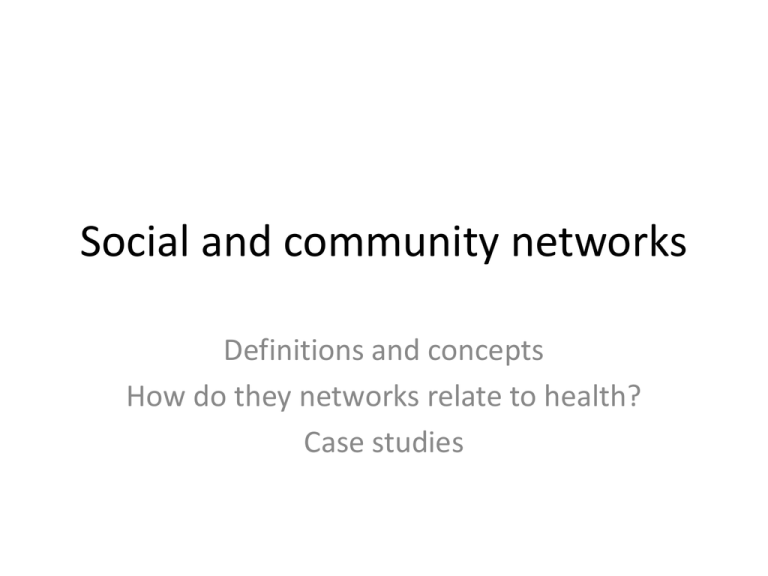Social and community networks
advertisement

Social and community networks Definitions and concepts How do they networks relate to health? Case studies Session outcomes • To outline the nature of social and community networks • To define the concepts of social support and social capital • To examine how these networks influence health What are networks? • Social and community networks are primarily concerned with interactions between groups of people and/or organisations & institutions. • Social networks can be analysed in terms structure ie number of people, frequency of contacts and diversity as well as the quality of the network and types of support given. What is social support- definition • Social support is defined “as information leading to the subject to believe [they are] cared for and loved, is esteemed and valued and belongs to a social network of communication and mutual obligation” (Cobb, 1976 p 301). • Tends to be used when examining more an individual level network • Reciprocity emphasises an extremely important element of social support for health where you not only receive social support but also give social support (Stansfeld, 2005). • This reciprocity has important implications for building connected communities and enhancing the health of communities. Elements of social support • House (1981) characterises four types of social support which also assess the quality of the network. • emotional ( eg love, trust, empathy); • appraisal (eg affirmation and feedback); • informational (eg advice ) • instrumental (eg tangible help money and time). How does social support work ? Adapted from Uchino (2006) Behavioural elements Healthy behaviours & advice Compliance of treatment plans Health Biological processes: Low blood pressure Social support Hormonal regulation Immune function Psychological processes Affirming and coping Control etc. outcomes Pathways of social support • Behavioural- social networks can promote healthy behaviours such as physical activity & relaxation • Psychological – social network can promote sense of belonging and be valued leading to strong selfesteem. It can also facilitate coping strategies in response to difficulties. It is hypothesised these pathways can lead to physiological changes that improve health outcomes Evidence of importance of social support for health • Berkman and Syme (1979) found that people who were less socially integrated had higher mortality rates consistently over a nine year period and concluded that social support protected to some extent against premature death. • The strongest evidence is between social support and coronary heart disease (Brummett et al., 2001). Examples • People in the social network provided support that lead to psychological adjustment in people with HIV (Turner-Cobb et al., , 2002) • Social support associated with well-being in young people (Po Sen Chu et al., , 2010) • Theorell et al., (1995) investigated how higher levels of social support predicted higher counts of CD4 cells in the blood (these are the cells in the immune system that HIV infect and destroy) What is social capital – definition ? • definition of social capital is “features of social organisation such as networks, norms, and social trust that facilitate co-ordination and collaboration for mutual benefit” (Putnam, 1995 p 67). • More of a meso/ecological-level of communities level concept emphasising institutional networks. Types of social capital (Office of National Statistics, 2003) • Bonding social capital- based on enduring, relationships between similar people with strong mutual commitments such as among friends, family and other close-knit groups. • Bridging social capital - formed from the connections between people who have less in common, but may have overlapping interests, for example, between neighbours, colleagues, or between different groups within a community. “It acts like a sociological superglue, binding together groups in the community and so can facilitate common action” (McKenzie and Harpham, 2006 p15) • Linking social capital - between people or organisations cutting across status and similarity and enabling people to exert influence and obtain resources outside their usual networks. This type of social capital is important for accessing services such as welfare benefits Measurement of social capital • No consensus although many researchers focus on aspects of trust between social and community networks but also on trust we place in institutions. Amounts of social capital • Health Development Agency UK (2004) measured social capital and found . People in more disadvantaged groups were generally more likely to know and speak to their neighbours but less likely to trust them. Nearly 60% of respondents felt well informed about local affairs A quarter felt that they could personally influence decisions in their area Summary of mechanisms adapted from Berkman et al., (2000) How social capital work ? Not well elucidated hypotheses include: • In communities that trust each, other relations between people are likely to be more co-operative and less stressful. • More egalitarian societies tend to engender a spirit of reciprocity fostering closer bonds and bridges, greater spirit of social support leading to direct physiological process that shape our health. • Seeing inequalities may lead to both discontentment and feed into both psychological and biological pathways. “A house may be large or small as long as the surrounding houses are equally small it satisfies all social demands for a dwelling. But if a palace arises beside a little house the little house shrinks to a hovel ………more dissatisfied and cramped” (Marx, nd cited in Marmott and Wilkinson, 2001p 1234). Examples of social capital and health • Membership in voluntary groups and higher levels of social trust had a more equal income structure and had lower total and disease specific mortality rates (Kawachi, et al., 1997). • Men with low social capital were nearly twice as likely to have a psychiatric disorder (Rose, 2000) • The prevalence of poor self-rated health was higher in neighbourhoods with more family ties, less integration into the wider society, and lower levels of trust (Stafford et al., 2004) Settings for generating social support and social capital • Family although strong family bonds can weaken bridging and linking social capital. • Neighbourhoods and local areas • Faith-based organisations • Schools Implications for policy and practice Influences the nature and methods of action • Favours community development, bottom up and empowerment approaches of action. • Promotes civic engagement and belonging to community groups • Promotes spirit of volunteerism • Consideration of how communities are networks and how these networks may be built. Summary • Social support and social capital are interlinked conceptually • Clear evidence of links between social support and social capital have been found. • Mechanisms linking social support and social capital to health outcomes are hypothesised but not well elucidated • Social support and social capital for practitioners work with communities.











